airbag MERCEDES-BENZ E-CLASS SALOON 2008 Owners Manual
[x] Cancel search | Manufacturer: MERCEDES-BENZ, Model Year: 2008, Model line: E-CLASS SALOON, Model: MERCEDES-BENZ E-CLASS SALOON 2008Pages: 401, PDF Size: 6.89 MB
Page 6 of 401
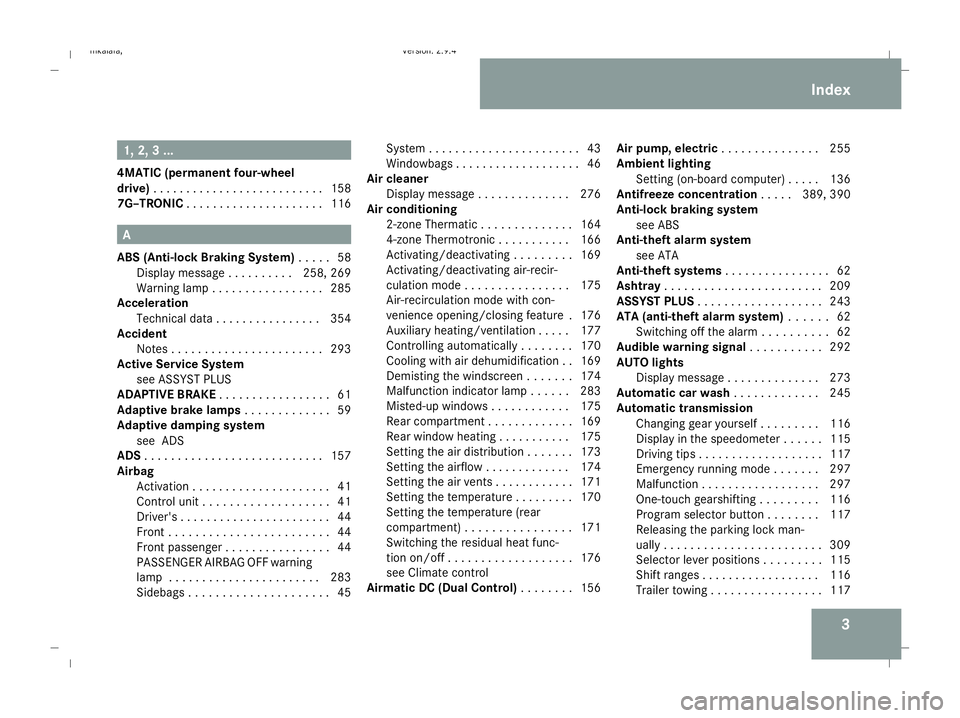
31, 2, 3 ...
4MATIC (permanent four-wheel
drive) . . . . . . . . . . . . . . . . . . . . . . . . . .158
7G–TRONIC . . . . . . . . . . . . . . . . . . . . .116 A
ABS (Anti-lock Braking System) . . . ..58
Display message . . . . . . . . . .258, 269
Warning lamp . . . . . . . . . . . . . . . . .285
Acceleration
Technical data . . . . . . . . . . . . . . . .354
Accident
Notes . . . . . . . . . . . . . . . . . . . . . . .293
Active Service System
see ASSYST PLUS
ADAPTIVE BRAKE . . . . . . . . . . . . . . . . .61
Adaptive brake lamps . . . . . . . . . . . ..59
Adaptive damping system see ADS
ADS . . . . . . . . . . . . . . . . . . . . . . . . . . .157
Airbag Activatio n.. . . . . . . . . . . . . . . . . . . .41
Control unit . . . . . . . . . . . . . . . . . . .41
Driver's . . . . . . . . . . . . . . . . . . . . . . .44
Front . . . . . . . . . . . . . . . . . . . . . . . .44
Front passenger . . . . . . . . . . . . . . . .44
PASSENGER AIRBAG OFF warning
lamp . . . . . . . . . . . . . . . . . . . . . . .283
Sidebag s.. . . . . . . . . . . . . . . . . . . .45System . . . . . . . . . . . . . . . . . . . . . .
.43
Windowbags . . . . . . . . . . . . . . . . . . .46
Air cleaner
Display message . . . . . . . . . . . . . .276
Air conditioning
2-zone Thermatic . . . . . . . . . . . . . .164
4-zone Thermotronic . . . . . . . . . . .166
Activating/deactivating . . . . . . . . .169
Activating/deactivating air-recir-
culation mode . . . . . . . . . . . . . . . .175
Air-recirculation mode with con-
venience opening/closing feature .176
Auxiliary heating/ventilation . . . . .177
Controlling automatically . . . . . . . .170
Cooling with air dehumidification . .169
Demisting the windscreen . . . . . . .174
Malfunction indicator lamp . . . . . .283
Misted-up windows . . . . . . . . . . . .175
Rear compartment . . . . . . . . . . . . .169
Rear window heating . . . . . . . . . . .175
Setting the air distribution . . . . . . .173
Setting the airflow . . . . . . . . . . . . .174
Setting the air vents . . . . . . . . . . . .171
Setting the temperature . . . . . . . . .170
Setting the temperature (rear
compartment) . . . . . . . . . . . . . . . .171
Switching the residual heat func-
tion on/off . . . . . . . . . . . . . . . . . . .176
see Climate control
Airmatic DC (Dual Control) . . . . . . ..156 Air pump, electric
. . . . . . . . . . . . . ..255
Ambient lighting Setting (on-board computer) . . . . .136
Antifreeze concentration . . . ..389, 390
Anti-lock braking system see ABS
Anti-theft alarm system
see ATA
Anti-theft systems . . . . . . . . . . . . . . ..62
Ashtray . . . . . . . . . . . . . . . . . . . . . . . .209
ASSYST PLUS . . . . . . . . . . . . . . . . . . .243
ATA (anti-theft alarm system) . . . . ..62
Switching off the alarm . . . . . . . . . .62
Audible warning signal . . . . . . . . . ..292
AUTO lights Display message . . . . . . . . . . . . . .273
Automatic car wash . . . . . . . . . . . ..245
Automatic transmission Changing gear yoursel f.. . . . . . . .116
Display in the speedometer . . . . . .115
Driving tips . . . . . . . . . . . . . . . . . . .117
Emergency running mode . . . . . . .297
Malfunction . . . . . . . . . . . . . . . . . .297
One-touch gearshifting . . . . . . . . .116
Program selector button . . . . . . . .117
Releasing the parking lock man-
ually . . . . . . . . . . . . . . . . . . . . . . . .309
Selector lever positions . . . . . . . . .115
Shift ranges . . . . . . . . . . . . . . . . . .116
Trailer towing . . . . . . . . . . . . . . . . .117 Index
211_AKB; 2; 5, en-GB
mkalafa,
Version: 2.9.4
2008-02-29T16:57:07+01:00 - Seite 3 Dateiname: 6515_3416_02_buchblock.pdf; preflight
Page 9 of 401
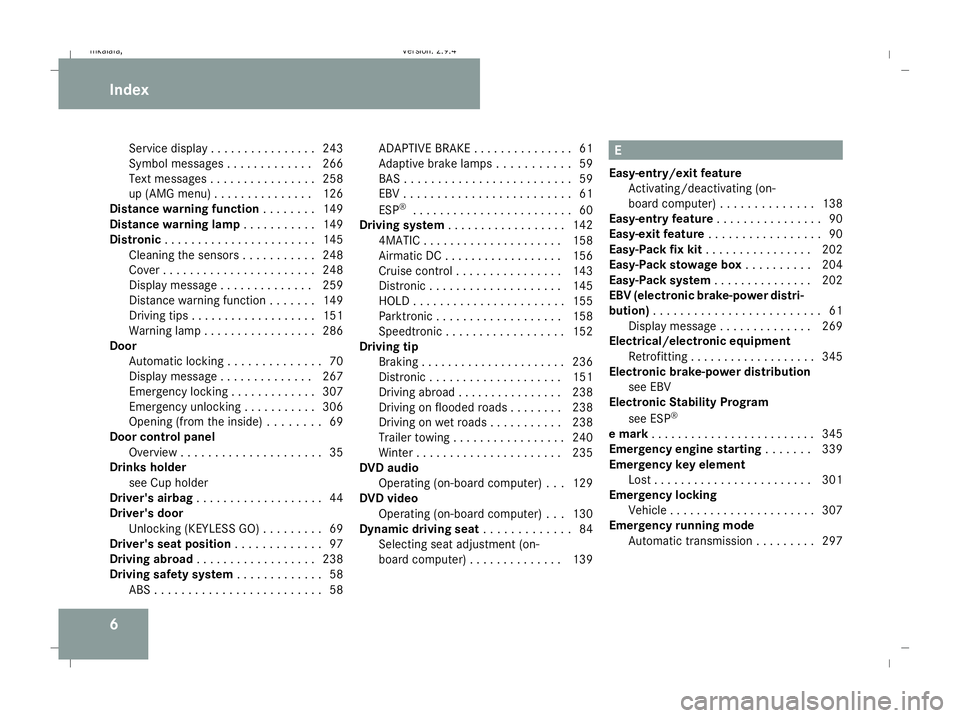
6Service display . . . . . . . . . . . . . . .
.243
Symbol messages . . . . . . . . . . . . .266
Text messages . . . . . . . . . . . . . . . .258
up (AMG menu) . . . . . . . . . . . . . . .126
Distance warning function . . . . . . ..149
Distance warning lamp . . . . . . . . . ..149
Distronic . . . . . . . . . . . . . . . . . . . . . . .145
Cleaning the sensors . . . . . . . . . . .248
Cove r.. . . . . . . . . . . . . . . . . . . . . .248
Display message . . . . . . . . . . . . . .259
Distance warning function . . . . . . .149
Driving tips . . . . . . . . . . . . . . . . . . .151
Warning lamp . . . . . . . . . . . . . . . . .286
Door
Automatic locking . . . . . . . . . . . . . .70
Display message . . . . . . . . . . . . . .267
Emergency locking . . . . . . . . . . . . .307
Emergency unlocking . . . . . . . . . . .306
Opening (from the inside) . . . . . . . .69
Door control panel
Overview . . . . . . . . . . . . . . . . . . . . .35
Drinks holder
see Cup holder
Driver's airbag . . . . . . . . . . . . . . . . . . .44
Driver's door Unlocking (KEYLESS GO) . . . . . . . . .69
Driver's seat position . . . . . . . . . . . ..97
Driving abroad . . . . . . . . . . . . . . . . . .238
Driving safety system . . . . . . . . . . . ..58
ABS . . . . . . . . . . . . . . . . . . . . . . . . .58ADAPTIVE BRAK
E.. . . . . . . . . . . . . .61
Adaptive brake lamps . . . . . . . . . . .59
BAS . . . . . . . . . . . . . . . . . . . . . . . . .59
EBV . . . . . . . . . . . . . . . . . . . . . . . . .61
ESP ®
. . . . . . . . . . . . . . . . . . . . . . . .60
Driving system . . . . . . . . . . . . . . . . . .142
4MATIC . . . . . . . . . . . . . . . . . . . . .158
Airmatic DC . . . . . . . . . . . . . . . . . .156
Cruise control . . . . . . . . . . . . . . . .143
Distronic . . . . . . . . . . . . . . . . . . . .145
HOLD . . . . . . . . . . . . . . . . . . . . . . .155
Parktroni c.. . . . . . . . . . . . . . . . . .158
Speedtronic . . . . . . . . . . . . . . . . . .152
Driving tip
Braking . . . . . . . . . . . . . . . . . . . . . .236
Distronic . . . . . . . . . . . . . . . . . . . .151
Driving abroad . . . . . . . . . . . . . . . .238
Driving on flooded road s.. . . . . ..238
Driving on wet road s.. . . . . . . . ..238
Trailer towing . . . . . . . . . . . . . . . . .240
Winter . . . . . . . . . . . . . . . . . . . . . .235
DVD audio
Operating (on-board computer) . . .129
DVD video
Operating (on-board computer) . . .130
Dynamic driving seat . . . . . . . . . . . ..84
Selecting seat adjustment (on-
board computer) . . . . . . . . . . . . . .139 E
Easy-entry/exit feature Activating/deactivating (on-
board computer) . . . . . . . . . . . . . .138
Easy-entry feature . . . . . . . . . . . . . . ..90
Easy-exit feature . . . . . . . . . . . . . . . . .90
Easy-Pack fix kit . . . . . . . . . . . . . . . .202
Easy-Pack stowage box . . . . . . . . ..204
Easy-Pack system . . . . . . . . . . . . . ..202
EBV (electronic brake-power distri-
bution) . . . . . . . . . . . . . . . . . . . . . . . . .61
Display message . . . . . . . . . . . . . .269
Electrical/electronic equipment
Retrofitting . . . . . . . . . . . . . . . . . . .345
Electronic brake-power distribution
see EBV
Electronic Stability Program
see ESP ®
e mark . . . . . . . . . . . . . . . . . . . . . . . . .345
Emergency engine starting . . . . . ..339
Emergency key element Lost . . . . . . . . . . . . . . . . . . . . . . . .301
Emergency locking
Vehicle . . . . . . . . . . . . . . . . . . . . . .307
Emergency running mode
Automatic transmission . . . . . . . . .297 Index
211_AKB; 2; 5, en-GB
mkalafa,
Version: 2.9.4 2008-02-29T16:57:07+01:00 - Seite 6Dateiname: 6515_3416_02_buchblock.pdf; preflight
Page 10 of 401
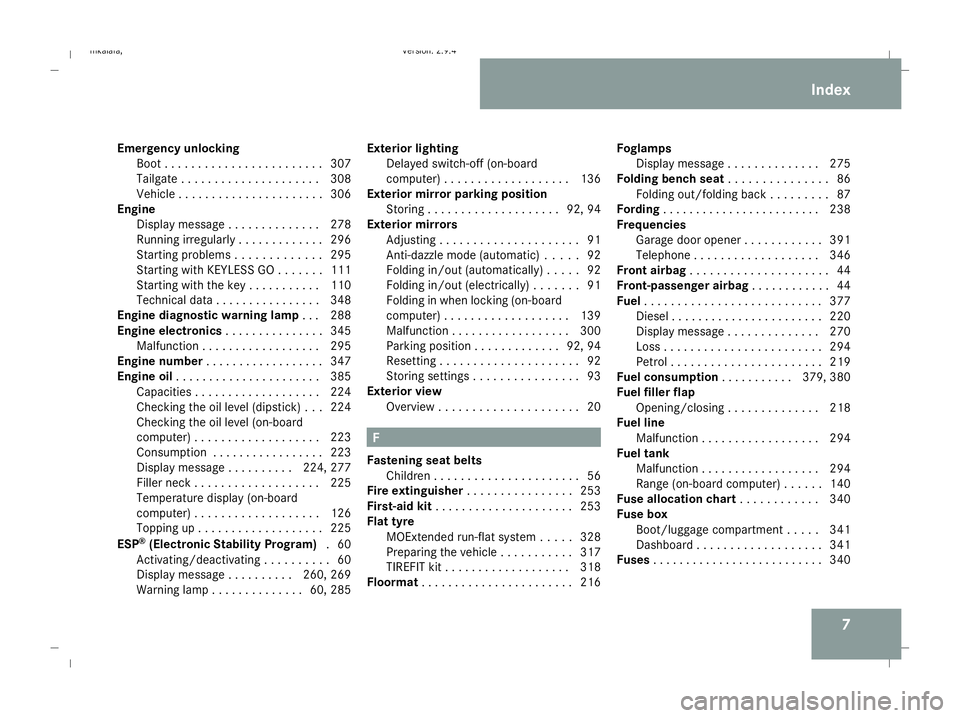
7
Emergency unlocking
Boo t.. . . . . . . . . . . . . . . . . . . . . . .307
Tailgate . . . . . . . . . . . . . . . . . . . . .308
Vehicle . . . . . . . . . . . . . . . . . . . . . .306
Engine
Display message . . . . . . . . . . . . . .278
Running irregularl y.. . . . . . . . . . . .296
Starting problems . . . . . . . . . . . . .295
Starting with KEYLESS GO . . . . . . .111
Starting with the key . . . . . . . . . . .110
Technical data . . . . . . . . . . . . . . . .348
Engine diagnostic warning lamp . ..2 88
Engine electronics . . . . . . . . . . . . . ..345
Malfunction . . . . . . . . . . . . . . . . . .295
Engine number . . . . . . . . . . . . . . . . . .347
Engine oil . . . . . . . . . . . . . . . . . . . . . .385
Capacities . . . . . . . . . . . . . . . . . . .224
Checking the oil level (dipstick) . . .224
Checking the oil level (on-board
computer) . . . . . . . . . . . . . . . . . . .223
Consumption . . . . . . . . . . . . . . . . .223
Display message . . . . . . . . . .224, 277
Filler neck . . . . . . . . . . . . . . . . . . .225
Temperature display (on-board
computer) . . . . . . . . . . . . . . . . . . .126
Topping up . . . . . . . . . . . . . . . . . . .225
ESP ®
(Electronic Stability Program) .60
Activating/deactivating . . . . . . . . . .60
Display message . . . . . . . . . .260, 269
Warning lamp . . . . . . . . . . . . . .60, 285 Exterior lighting
Delayed switch-off (on-board
computer) . . . . . . . . . . . . . . . . . . .136
Exterior mirror parking position
Storing . . . . . . . . . . . . . . . . . . . .92, 94
Exterior mirrors
Adjusting . . . . . . . . . . . . . . . . . . . . .91
Anti-dazzle mode (automatic) . . . . .92
Folding in/out (automatically ).. . . .92
Folding in/out (electrically) . . . . . . .91
Folding in when locking (on-board
computer) . . . . . . . . . . . . . . . . . . .139
Malfunction . . . . . . . . . . . . . . . . . .300
Parking position . . . . . . . . . . . . .92, 94
Resetting . . . . . . . . . . . . . . . . . . . . .92
Storing settings . . . . . . . . . . . . . . . .93
Exterior view
Overview . . . . . . . . . . . . . . . . . . . . .20 F
Fastening seat belts Children . . . . . . . . . . . . . . . . . . . . . .56
Fire extinguisher . . . . . . . . . . . . . . . .253
First-aid kit . . . . . . . . . . . . . . . . . . . . .253
Flat tyre MOExtended run-flat system . . . . .328
Preparing the vehicle . . . . . . . . . . .317
TIREFIT kit . . . . . . . . . . . . . . . . . . .318
Floormat . . . . . . . . . . . . . . . . . . . . . . .216 Foglamps
Display message . . . . . . . . . . . . . .275
Folding bench seat . . . . . . . . . . . . . ..86
Folding out/folding back . . . . . . . . .87
Fording . . . . . . . . . . . . . . . . . . . . . . . .238
Frequencies Garage door opener . . . . . . . . . . . .391
Telephone . . . . . . . . . . . . . . . . . . .346
Front airbag . . . . . . . . . . . . . . . . . . . . .44
Front-passenger airbag . . . . . . . . . . ..44
Fuel . . . . . . . . . . . . . . . . . . . . . . . . . . .377
Diese l.. . . . . . . . . . . . . . . . . . . . . .220
Display message . . . . . . . . . . . . . .270
Loss . . . . . . . . . . . . . . . . . . . . . . . .294
Petrol . . . . . . . . . . . . . . . . . . . . . . .219
Fuel consumption . . . . . . . . . ..379, 380
Fuel filler flap Opening/closing . . . . . . . . . . . . . .218
Fuel line
Malfunction . . . . . . . . . . . . . . . . . .294
Fuel tank
Malfunction . . . . . . . . . . . . . . . . . .294
Range (on-board computer) . . . . . .140
Fuse allocation chart . . . . . . . . . . ..340
Fuse box Boot/luggage compartment . . . . .341
Dashboard . . . . . . . . . . . . . . . . . . .341
Fuses . . . . . . . . . . . . . . . . . . . . . . . . . .340 Index
211_AKB; 2; 5, en-GB
mkalafa,
Version: 2.9.4
2008-02-29T16:57:07+01:00 - Seite 7 Dateiname: 6515_3416_02_buchblock.pdf; preflight
Page 11 of 401
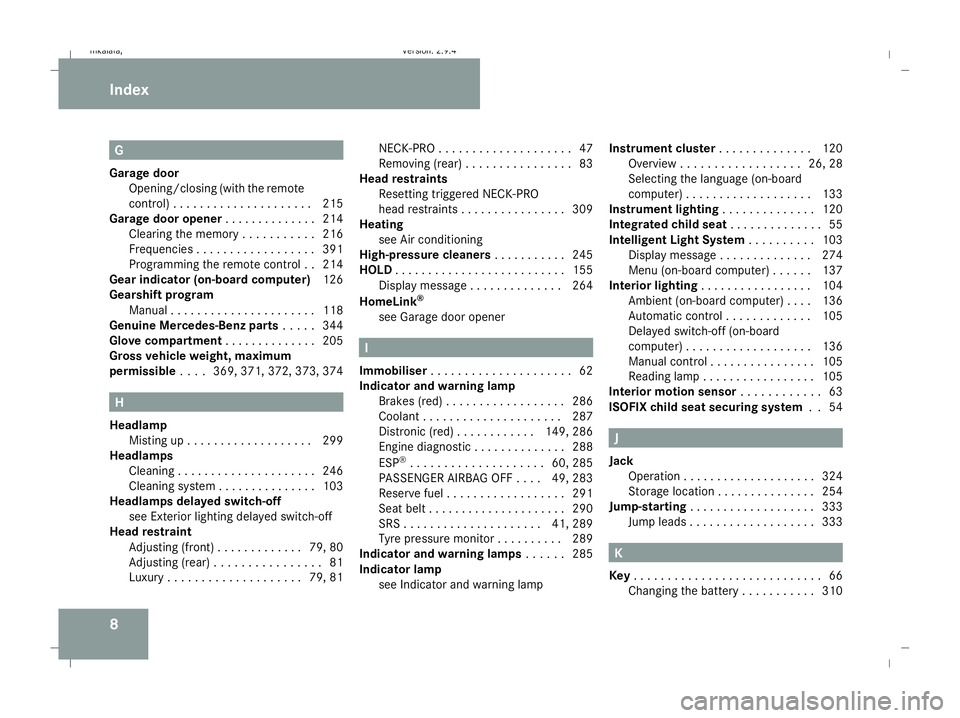
8 G
Garage door Opening/closing (with the remote
control) . . . . . . . . . . . . . . . . . . . . .215
Garage door opener . . . . . . . . . . . . ..214
Clearing the memory . . . . . . . . . . .216
Frequencies . . . . . . . . . . . . . . . . . .391
Programming the remote control . .214
Gear indicator (on-board computer) 126
Gearshift program Manual . . . . . . . . . . . . . . . . . . . . . .118
Genuine Mercedes-Benz parts . . . ..344
Glove compartment . . . . . . . . . . . . ..205
Gross vehicle weight, maximum
permissible . . ..369, 371, 372, 373, 374 H
Headlamp Misting up . . . . . . . . . . . . . . . . . . .299
Headlamps
Cleaning . . . . . . . . . . . . . . . . . . . . .246
Cleaning system . . . . . . . . . . . . . . .103
Headlamps delayed switch-off
see Exterior lighting delayed switch-off
Head restraint
Adjusting (front) . . . . . . . . . . . . .79, 80
Adjusting (rear) . . . . . . . . . . . . . . . .81
Luxury . . . . . . . . . . . . . . . . . . . .79, 81 NECK-PR
O.. . . . . . . . . . . . . . . . . . .47
Removing (rear) . . . . . . . . . . . . . . . .83
Head restraints
Resetting triggered NECK-PRO
head restraints . . . . . . . . . . . . . . . .309
Heating
see Air conditioning
High-pressure cleaners . . . . . . . . . ..245
HOLD . . . . . . . . . . . . . . . . . . . . . . . . . .155
Display message . . . . . . . . . . . . . .264
HomeLink ®
see Garage door opener I
Immobiliser . . . . . . . . . . . . . . . . . . . . .62
Indicator and warning lamp Brakes (red ).. . . . . . . . . . . . . . . . .286
Coolant . . . . . . . . . . . . . . . . . . . . .287
Distronic (red ).. . . . . . . . . . .149, 286
Engine diagnostic . . . . . . . . . . . . . .288
ESP ®
. . . . . . . . . . . . . . . . . . . .60, 285
PASSENGER AIRBAG OFF . . . .49, 283
Reserve fuel . . . . . . . . . . . . . . . . . .291
Seat belt . . . . . . . . . . . . . . . . . . . . .290
SRS . . . . . . . . . . . . . . . . . . . . .41, 289
Tyre pressure monitor . . . . . . . . . .289
Indicator and warning lamps . . . . ..285
Indicator lamp see Indicator and warning lamp Instrument cluster
. . . . . . . . . . . . ..120
Overview . . . . . . . . . . . . . . . . . .26, 28
Selecting the language (on-board
computer) . . . . . . . . . . . . . . . . . . .133
Instrument lighting . . . . . . . . . . . . ..120
Integrated child seat . . . . . . . . . . . . ..55
Intelligent Light System . . . . . . . . ..103
Display message . . . . . . . . . . . . . .274
Menu (on-board computer) . . . . . .137
Interior lighting . . . . . . . . . . . . . . . . .104
Ambient (on-board computer) . . . .136
Automatic control . . . . . . . . . . . . .105
Delayed switch-off (on-board
computer) . . . . . . . . . . . . . . . . . . .136
Manual control . . . . . . . . . . . . . . . .105
Reading lamp . . . . . . . . . . . . . . . . .105
Interior motion sensor . . . . . . . . . . ..63
ISOFIX child seat securing system ..54 J
Jack Operation . . . . . . . . . . . . . . . . . . . .324
Storage location . . . . . . . . . . . . . . .254
Jump-starting . . . . . . . . . . . . . . . . . . .333
Jump leads . . . . . . . . . . . . . . . . . . .333 K
Key . . . . . . . . . . . . . . . . . . . . . . . . . . . .66
Changing the battery . . . . . . . . . . .310 Index
211_AKB; 2; 5, en-GB
mkalafa,
Version: 2.9.4 2008-02-29T16:57:07+01:00 - Seite 8Dateiname: 6515_3416_02_buchblock.pdf; preflight
Page 14 of 401
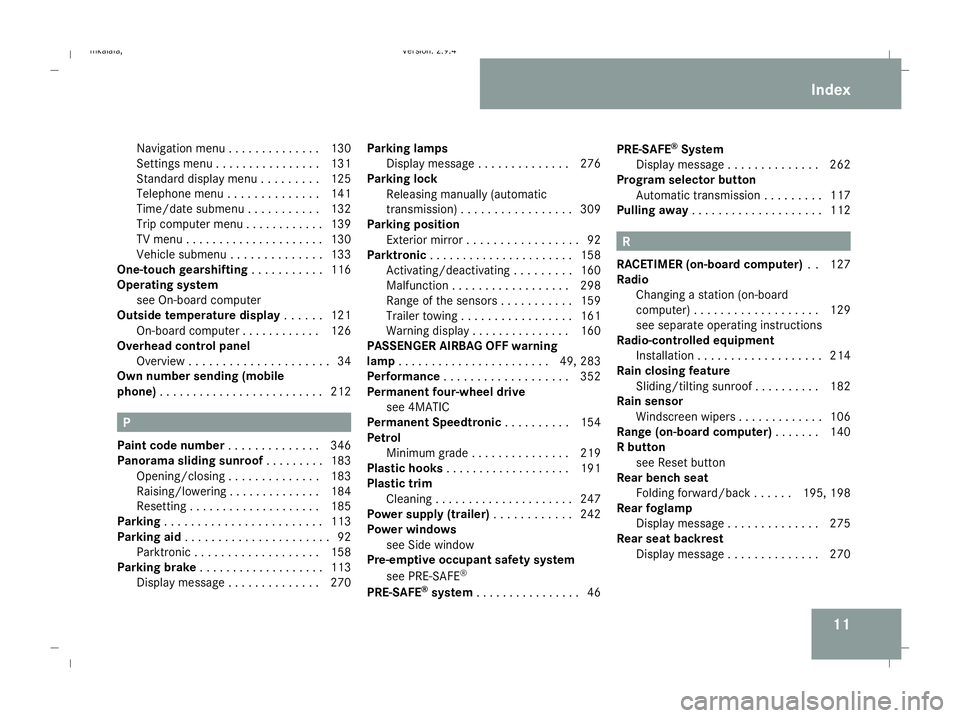
11
Navigation men
u.. . . . . . . . . . . . .130
Settings menu . . . . . . . . . . . . . . . .131
Standard display menu . . . . . . . . .125
Telephone menu . . . . . . . . . . . . . .141
Time/date submenu . . . . . . . . . . .132
Trip computer menu . . . . . . . . . . . .139
TV menu . . . . . . . . . . . . . . . . . . . . .130
Vehicle submenu . . . . . . . . . . . . . .133
One-touch gearshifting . . . . . . . . . ..116
Operating system see On-board computer
Outside temperature display . . . . ..121
On-board computer . . . . . . . . . . . .126
Overhead control panel
Overview . . . . . . . . . . . . . . . . . . . . .34
Own number sending (mobile
phone) . . . . . . . . . . . . . . . . . . . . . . . . .212 P
Paint code number . . . . . . . . . . . . ..346
Panorama sliding sunroof . . . . . . . ..183
Opening/closing . . . . . . . . . . . . . .183
Raising/lowering . . . . . . . . . . . . . .184
Resetting . . . . . . . . . . . . . . . . . . . .185
Parking . . . . . . . . . . . . . . . . . . . . . . . .113
Parking aid . . . . . . . . . . . . . . . . . . . . . .92
Parktronic . . . . . . . . . . . . . . . . . . .158
Parking brake . . . . . . . . . . . . . . . . . . .113
Display message . . . . . . . . . . . . . .270 Parking lamps
Display message . . . . . . . . . . . . . .276
Parking lock
Releasing manually (automatic
transmission) . . . . . . . . . . . . . . . . .309
Parking position
Exterior mirror . . . . . . . . . . . . . . . . .92
Parktronic . . . . . . . . . . . . . . . . . . . . . .158
Activating/deactivating . . . . . . . . .160
Malfunction . . . . . . . . . . . . . . . . . .298
Range of the sensors . . . . . . . . . . .159
Trailer towing . . . . . . . . . . . . . . . . .161
Warning display . . . . . . . . . . . . . . .160
PASSENGER AIRBAG OFF warning
lamp . . . . . . . . . . . . . . . . . . . . . . .49, 283
Performance . . . . . . . . . . . . . . . . . . .352
Permanent four-wheel drive see 4MATIC
Permanent Speedtronic . . . . . . . . ..154
Petrol Minimum grad e.. . . . . . . . . . . . . .219
Plastic hooks . . . . . . . . . . . . . . . . . . .191
Plastic trim Cleaning . . . . . . . . . . . . . . . . . . . . .247
Power supply (trailer) . . . . . . . . . . ..242
Power windows see Side window
Pre-emptive occupant safety system
see PRE-SAFE ®
PRE-SAFE ®
system . . . . . . . . . . . . . . . .46PRE-SAFE
®
System
Display message . . . . . . . . . . . . . .262
Program selector button
Automatic transmission . . . . . . . . .117
Pulling away . . . . . . . . . . . . . . . . . . . .112 R
RACETIMER (on-board computer) ..1 27
Radio Changing a station (on-board
computer) . . . . . . . . . . . . . . . . . . .129
see separate operating instructions
Radio-controlled equipment
Installatio n.. . . . . . . . . . . . . . . . . .214
Rain closing feature
Sliding/tilting sunroo f.. . . . . . . ..182
Rain sensor
Windscreen wipers . . . . . . . . . . . . .106
Range (on-board computer) . . . . . ..140
R button see Reset button
Rear bench seat
Folding forward/back . . . . . .195, 198
Rear foglamp
Display message . . . . . . . . . . . . . .275
Rear seat backrest
Display message . . . . . . . . . . . . . .270 Index
211_AKB; 2; 5, en-GB
mkalafa,
Version: 2.9.4
2008-02-29T16:57:07+01:00 - Seite 11 Dateiname: 6515_3416_02_buchblock.pdf; preflight
Page 36 of 401
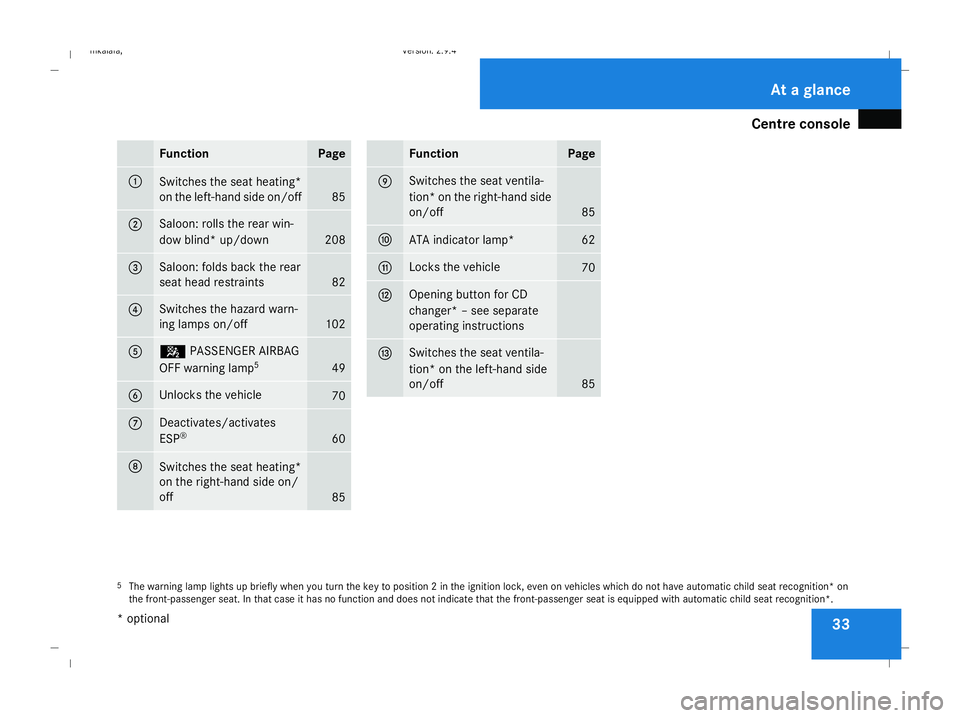
Centre console
33Function Page
1
Switches the seat heating*
on the left-hand side on/off
85
2 Saloon: rolls the rear win-
dow blind* up/down
208
3 Saloon: folds back the rear
seat head restraints
82
4 Switches the hazard warn-
ing lamps on/off
102
5 5
PASSENGER AIRBAG
OFF warning lamp 5 49
6 Unlocks the vehicle
70
7 Deactivates/activates
ESP
® 60
8
Switches the seat heating*
on the right-hand side on/
off
85 Function Page
9 Switches the seat ventila-
tion
*on the right-hand side
on/off 85
a
ATA indicator lamp* 62
b Locks the vehicle
70
c Opening button for CD
changer* – see separate
operating instructions
d Switches the seat ventila-
tion* on the left-hand side
on/off
85
5
The warning lamp lights up briefly when you turn the key to position 2 in the ignition lock, even on vehicles which do not have automatic child seat recognition* on
the front-passenger seat. In that case it has no function and does not indicate that the front-passenger seat is equipped with automatic child seat recognition*. At a glance
* optional
211_AKB; 2; 5, en-GB
mkalafa,
Version: 2.9.4
2008-02-29T16:57:07+01:00 - Seite 33 Dateiname: 6515_3416_02_buchblock.pdf; preflight
Page 43 of 401
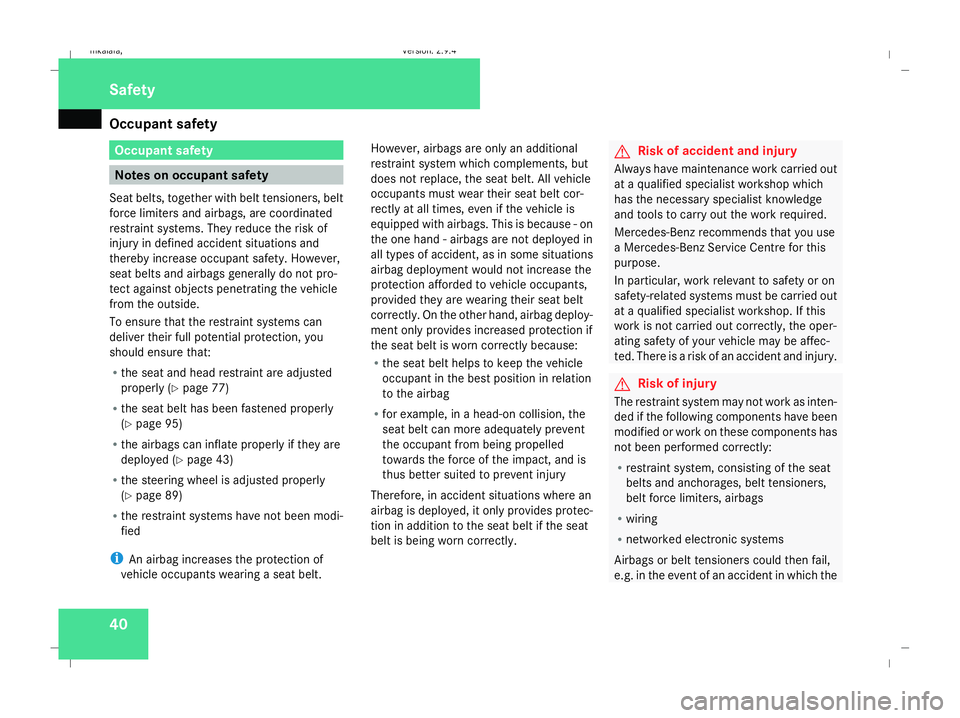
Occupant safety
40 Occupant safety
Notes on occupant safety
Seat belts, together with belt tensioners, belt
force limiters and airbags, are coordinated
restraint systems. They reduce the risk of
injury in defined accident situations and
thereby increase occupant safety. However,
seat belts and airbags generally do not pro-
tect against objects penetrating the vehicle
from the outside.
To ensure that the restraint systems can
deliver their full potential protection, you
should ensure that:
R the seat and head restraint are adjusted
properly (Y page 77)
R the seat belt has been fastened properly
(Y page 95)
R the airbags can inflate properly if they are
deployed (Y page 43)
R the steering wheel is adjusted properly
(Y page 89)
R the restraint systems have not been modi-
fied
i An airbag increases the protection of
vehicle occupants wearing a seat belt. However, airbags are only an additional
restraint system which complements, but
does not replace, the seat belt. All vehicle
occupants must wear their seat belt cor-
rectly at all times, even if the vehicle is
equipped with airbags. This is because - on
the one hand - airbags are not deployed in
all types of accident, as in some situations
airbag deployment would not increase the
protection afforded to vehicle occupants,
provided they are wearing their seat belt
correctly. On the other hand, airbag deploy-
ment only provides increased protection if
the seat belt is worn correctly because:
R
the seat belt helps to keep the vehicle
occupant in the best position in relation
to the airbag
R for example, in a head-on collision, the
seat belt can more adequately prevent
the occupant from being propelled
towards the force of the impact, and is
thus better suited to prevent injury
Therefore, in accident situations where an
airbag is deployed, it only provides protec-
tion in addition to the seat belt if the seat
belt is being worn correctly. G
Risk of accident and injury
Always have maintenance work carried out
at a qualified specialist workshop which
has the necessary specialist knowledge
and tools to carry out the work required.
Mercedes-Benz recommends that you use
a Mercedes-Benz Service Centre for this
purpose.
In particular, work relevant to safety or on
safety-related systems must be carried out
at a qualified specialist workshop. If this
work is not carried out correctly, the oper-
ating safety of your vehicle may be affec-
ted. There is a risk of an accident and injury. G
Risk of injury
The restraint system may not work as inten-
ded if the following components have been
modified or work on these components has
not been performed correctly:
R restraint system, consisting of the seat
belts and anchorages, belt tensioners,
belt force limiters, airbags
R wiring
R networked electronic systems
Airbags or belt tensioners could then fail,
e.g. in the event of an accident in which the Safety
211_AKB; 2; 5, en-GB
mkalafa,
Version: 2.9.4 2008-02-29T16:57:07+01:00 - Seite 40Dateiname: 6515_3416_02_buchblock.pdf; preflight
Page 44 of 401
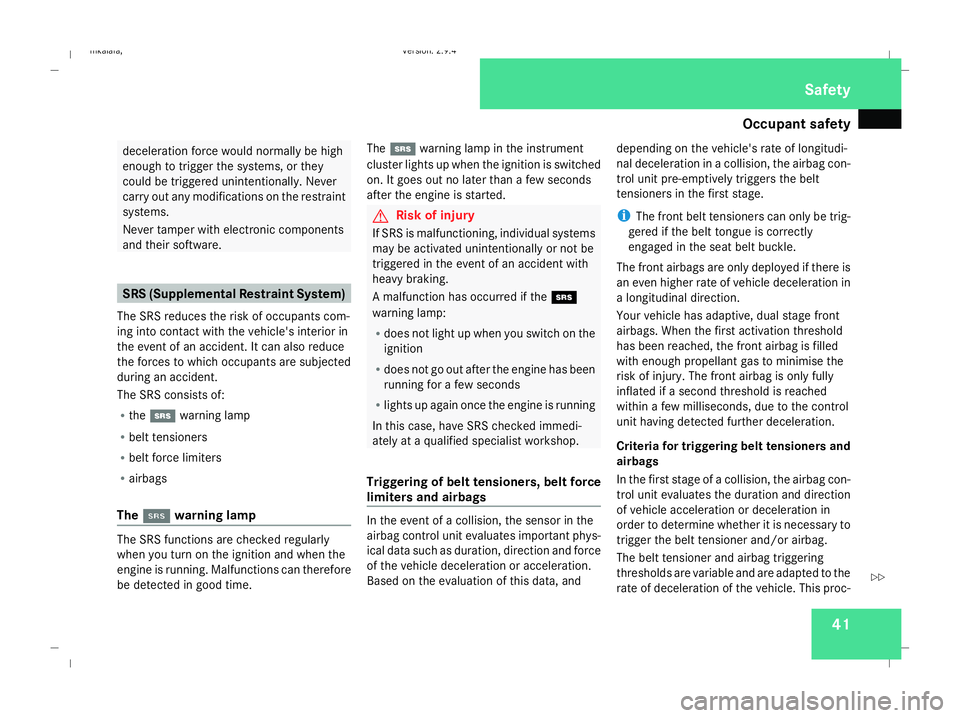
Occupant safety
41deceleration force would normally be high
enough to trigger the systems, or they
could be triggered unintentionally. Never
carry out any modifications on the restraint
systems.
Never tamper with electronic components
and their software.
SRS (Supplemental Restraint System)
The SRS reduces the risk of occupants com-
ing into contact with the vehicle's interior in
the event of an accident. It can also reduce
the forces to which occupants are subjected
during an accident.
The SRS consists of:
R the 1 warning lamp
R belt tensioners
R belt force limiters
R airbags
The 1 1 warning lamp The SRS functions are checked regularly
when you turn on the ignition and when the
engine is running. Malfunctions can therefore
be detected in good time. The
1 warning lamp in the instrument
cluster lights up when the ignition is switched
on. It goes out no later than a few seconds
after the engine is started. G
Risk of injury
If SRS is malfunctioning, individual systems
may be activated unintentionally or not be
triggered in the event of an accident with
heavy braking.
A malfunction has occurred if the 1
warning lamp:
R does not light up when you switch on the
ignition
R does not go out after the engine has been
running for a few seconds
R lights up again once the engine is running
In this case, have SRS checked immedi-
ately at a qualified specialist workshop.
Triggering of belt tensioners, belt force
limiters and airbags In the event of a collision, the sensor in the
airbag control unit evaluates important phys-
ical data such as duration, direction and force
of the vehicle deceleration or acceleration.
Based on the evaluation of this data, and depending on the vehicle's rate of longitudi-
nal deceleration in a collision, the airbag con-
trol unit pre-emptively triggers the belt
tensioners in the first stage.
i
The front belt tensioners can only be trig-
gered if the belt tongue is correctly
engaged in the seat belt buckle.
The front airbags are only deployed if there is
an even higher rate of vehicle deceleration in
a longitudinal direction.
Your vehicle has adaptive, dual stage front
airbags. When the first activation threshold
has been reached, the front airbag is filled
with enough propellant gas to minimise the
risk of injury. The front airbag is only fully
inflated if a second threshold is reached
within a few milliseconds, due to the control
unit having detected further deceleration.
Criteria for triggering belt tensioners and
airbags
In the first stage of a collision, the airbag con-
trol unit evaluates the duration and direction
of vehicle acceleration or deceleration in
order to determine whether it is necessary to
trigger the belt tensioner and/or airbag.
The belt tensioner and airbag triggering
thresholds are variable and are adapted to the
rate of deceleration of the vehicle. This proc- Safety
211_AKB; 2; 5, en-GB
mkalafa,
Version: 2.9.4
2008-02-29T16:57:07+01:00 - Seite 41 ZDateiname: 6515_3416_02_buchblock.pdf; preflight
Page 45 of 401
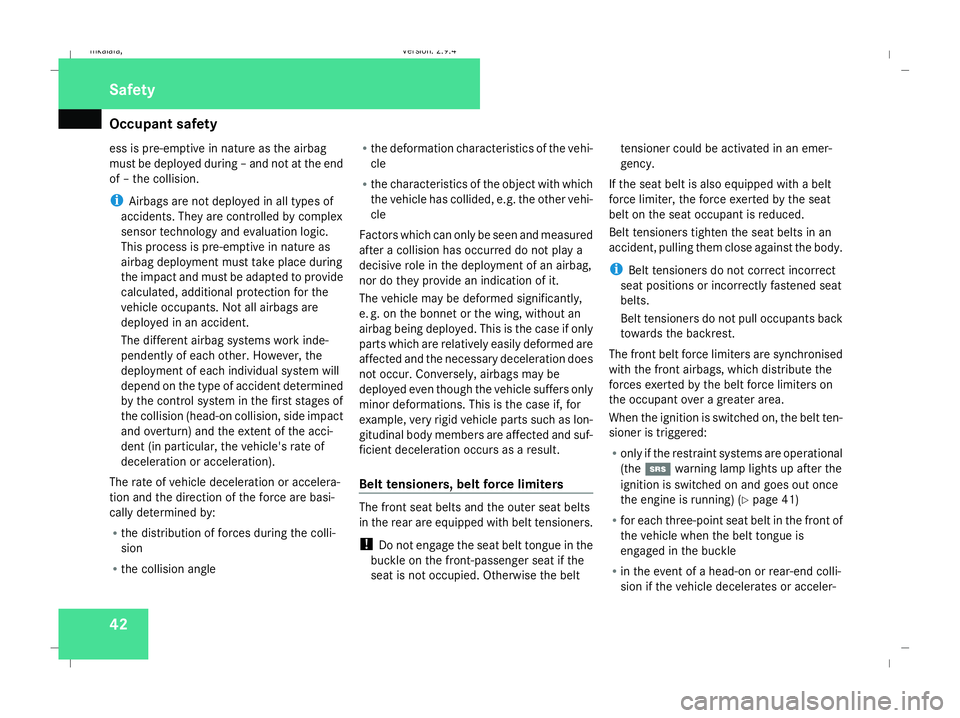
Occupant safety
42
ess is pre-emptive in nature as the airbag
must be deployed during – and not at the end
of – the collision.
i Airbags are not deployed in all types of
accidents. They are controlled by complex
sensor technology and evaluation logic.
This process is pre-emptive in nature as
airbag deployment must take place during
the impact and must be adapted to provide
calculated, additional protection for the
vehicle occupants. Not all airbags are
deployed in an accident.
The different airbag systems work inde-
pendently of each other. However, the
deployment of each individual system will
depend on the type of accident determined
by the control system in the first stages of
the collision (head-on collision, side impact
and overturn) and the extent of the acci-
dent (in particular, the vehicle's rate of
deceleration or acceleration).
The rate of vehicle deceleration or accelera-
tion and the direction of the force are basi-
cally determined by:
R the distribution of forces during the colli-
sion
R the collision angle R
the deformation characteristics of the vehi-
cle
R the characteristics of the object with which
the vehicle has collided, e.g. the other vehi-
cle
Factors which can only be seen and measured
after a collision has occurred do not play a
decisive role in the deployment of an airbag,
nor do they provide an indication of it.
The vehicle may be deformed significantly,
e. g. on the bonnet or the wing, without an
airbag being deployed. This is the case if only
parts which are relatively easily deformed are
affected and the necessary deceleration does
not occur. Conversely, airbags may be
deployed even though the vehicle suffers only
minor deformations. This is the case if, for
example, very rigid vehicle parts such as lon-
gitudinal body members are affected and suf-
ficient deceleration occurs as a result.
Belt tensioners, belt force limiters The front seat belts and the outer seat belts
in the rear are equipped with belt tensioners.
!
Do not engage the seat belt tongue in the
buckle on the front-passenger seat if the
seat is not occupied. Otherwise the belt tensioner could be activated in an emer-
gency.
If the seat belt is also equipped with a belt
force limiter, the force exerted by the seat
belt on the seat occupant is reduced.
Belt tensioners tighten the seat belts in an
accident, pulling them close against the body.
i Belt tensioners do not correct incorrect
seat positions or incorrectly fastened seat
belts.
Belt tensioners do not pull occupants back
towards the backrest.
The front belt force limiters are synchronised
with the front airbags, which distribute the
forces exerted by the belt force limiters on
the occupant over a greater area.
When the ignition is switched on, the belt ten-
sioner is triggered:
R only if the restraint systems are operational
(the 1 warning lamp lights up after the
ignition is switched on and goes out once
the engine is running) (Y page 41)
R for each three-point seat belt in the front of
the vehicle when the belt tongue is
engaged in the buckle
R in the event of a head-on or rear-end colli-
sion if the vehicle decelerates or acceler- Safety
211_AKB; 2; 5, en-GB
mkalafa,
Version: 2.9.4 2008-02-29T16:57:07+01:00 - Seite 42Dateiname: 6515_3416_02_buchblock.pdf; preflight
Page 46 of 401
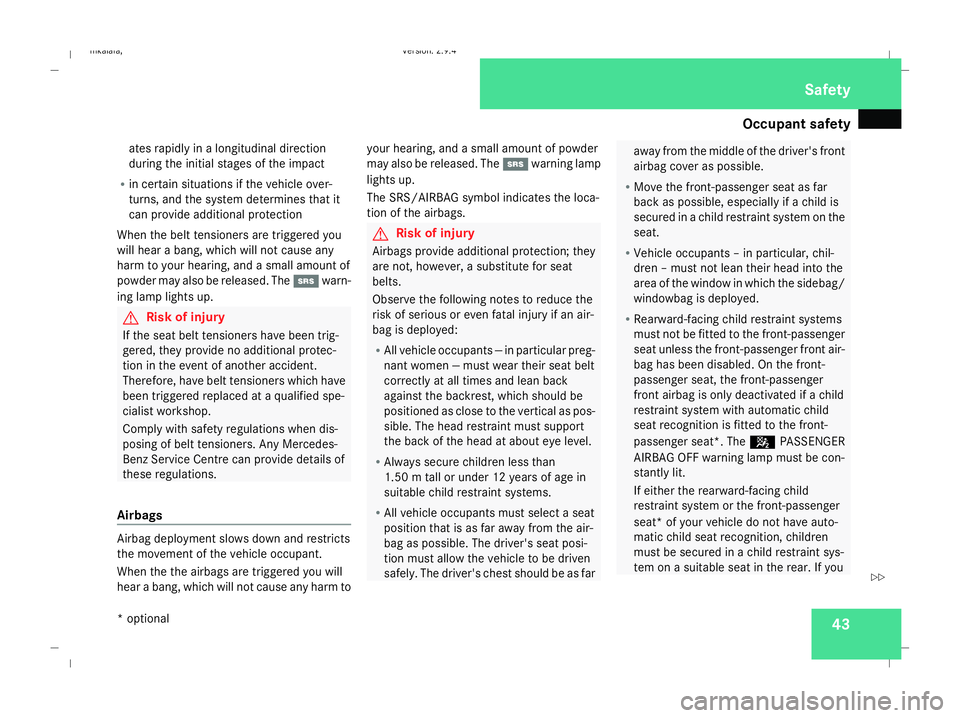
Occupant safety
43
ates rapidly in a longitudinal direction
during the initial stages of the impact
R in certain situations if the vehicle over-
turns, and the system determines that it
can provide additional protection
When the belt tensioners are triggered you
will hear a bang, which will not cause any
harm to your hearing, and a small amount of
powder may also be released. The 1warn-
ing lamp lights up. G
Risk of injury
If the seat belt tensioners have been trig-
gered, they provide no additional protec-
tion in the event of another accident.
Therefore, have belt tensioners which have
been triggered replaced at a qualified spe-
cialist workshop.
Comply with safety regulations when dis-
posing of belt tensioners. Any Mercedes-
Benz Service Centre can provide details of
these regulations.
Airbags Airbag deployment slows down and restricts
the movement of the vehicle occupant.
When the the airbags are triggered you will
hear a bang, which will not cause any harm to your hearing, and a small amount of powder
may also be released. The
1warning lamp
lights up.
The SRS/AIRBAG symbol indicates the loca-
tion of the airbags. G
Risk of injury
Airbags provide additional protection; they
are not, however, a substitute for seat
belts.
Observe the following notes to reduce the
risk of serious or even fatal injury if an air-
bag is deployed:
R All vehicle occupants — in particular preg-
nant women — must wear their seat belt
correctly at all times and lean back
against the backrest, which should be
positioned as close to the vertical as pos-
sible. The head restraint must support
the back of the head at about eye level.
R Always secure children less than
1.50 m tall or under 12 years of age in
suitable child restraint systems.
R All vehicle occupants must select a seat
position that is as far away from the air-
bag as possible. The driver's seat posi-
tion must allow the vehicle to be driven
safely. The driver's chest should be as far away from the middle of the driver's front
airbag cover as possible.
R Move the front-passenger seat as far
back as possible, especially if a child is
secured in a child restraint system on the
seat.
R Vehicle occupants – in particular, chil-
dren – must not lean their head into the
area of the window in which the sidebag/
windowbag is deployed.
R Rearward-facing child restraint systems
must not be fitted to the front-passenger
seat unless the front-passenger front air-
bag has been disabled. On the front-
passenger seat, the front-passenger
front airbag is only deactivated if a child
restraint system with automatic child
seat recognition is fitted to the front-
passenger seat*. The 5PASSENGER
AIRBAG OFF warning lamp must be con-
stantly lit.
If either the rearward-facing child
restraint system or the front-passenger
seat* of your vehicle do not have auto-
matic child seat recognition, children
must be secured in a child restraint sys-
tem on a suitable seat in the rear. If you Safety
* optional
211_AKB; 2; 5, en-GB
mkalafa,
Version: 2.9.4
2008-02-29T16:57:07+01:00 - Seite 43 ZDateiname: 6515_3416_02_buchblock.pdf; preflight